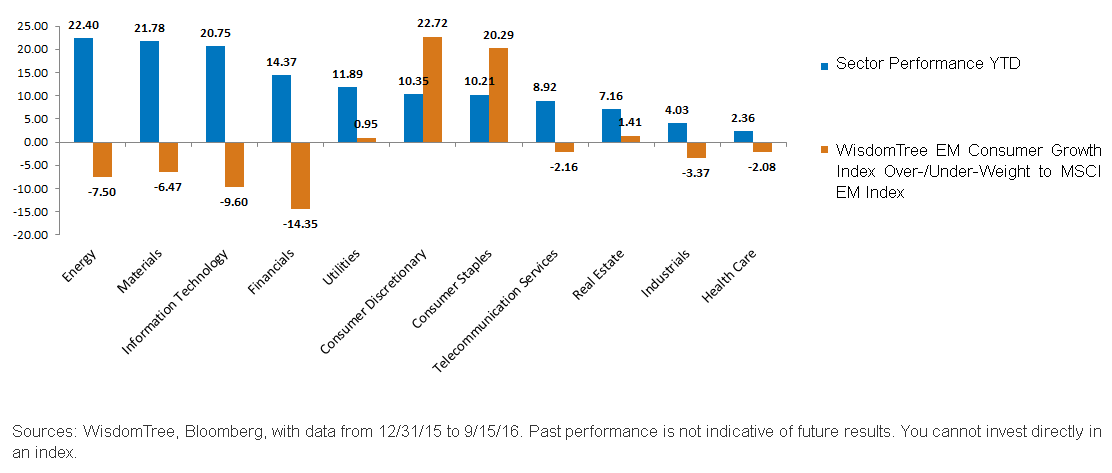Emerging Markets Rebound in 2016: More than Just Commodities


 • Under-Weight the Four Top-Performing Sectors: The four top-performing sectors in emerging markets were, in order, Energy, Materials, Information Technology and Financials. Interestingly, these were the sectors that represented the four largest under-weights for the WT Emerging Markets Consumer Growth strategy compared to the MSCI Emerging Markets Index.
• Overcoming a Headwind, Thanks to Selection: That the WT Emerging Markets Consumer Growth strategy was able to outperform the MSCI Index despite significant under-weights in the top-performing sectors seems counterintuitive. The bottom line: The individual stocks in the strategy, and the way in which they are weighted, were the driving force behind its outperformance. More specifically, it was also the country and currency exposure in the strategy, particularly within the strategy’s Brazilian holdings.
Digging Further into the Advantages of WT Emerging Markets Consumer Growth
But over the longer term, there are three primary factors that lead us to believe the advantages could have potential to continue:
1. Close Ties to EM GDP Growth: The plodding pace of global growth has been widely lamented for several years now. Emerging markets are growing at more than twice the rate of developed markets in 2016, and EM gross domestic product (GDP) growth is expected to accelerate into next year. Each constituent in the WT Emerging Markets Consumer Growth strategy must derive at least 60% of its revenue from emerging markets. This domestic focus should help the strategy benefit from a pickup in economic activity while keeping it relatively insulated against a slowdown in developed market growth.
2. Conscious of Valuations: Few investors would argue against the growth of the emerging markets consumer—but consensus often breeds expensiveness, which may help explain why the two consumer sectors in EM often trade at a substantial premium to the market. WisdomTree’s approach also includes sectors that stand to indirectly benefit from the rise of the EM consumer (such as mobile phone providers and health care companies) and that typically trade at less lofty valuations. Further, the strategy’s methodology rewards stocks with less expensive valuations and weights those stocks by their earnings, helping remove the risk of more expensive companies.
3. Size Does Not Imply Quality: Within WisdomTree’s Emerging Markets Consumer Growth Index, companies must prove themselves on both a return on equity (ROE) and a return on assets (ROA) basis over the past three years. This has the impact of screening out many of the larger, less efficient state-owned enterprises, which may not have maximizing shareholder returns as their core mission.
Has the Tide Finally Shifted?
We believe that the characteristics and design of this strategy position it as a very compelling long-term play on emerging markets economic growth. However, it was born during the 2013 “taper tantrum,” which launched one of the worst environments for emerging markets in recent history. 2016 has been the first time that this Index has been live AND emerging market equities have been in favor. We’re very happy with these initial results but are much more excited about the Index’s future prospects.
1United States: S&P 500 Index. International Developed: MSCI EAFE Index. Emerging Markets: MSCI Emerging Markets Index. Sources: WisdomTree, Bloomberg, 12/31/15–9/15/16.
2Source: Bloomberg.
3Sources: WisdomTree, Bloomberg.
• Under-Weight the Four Top-Performing Sectors: The four top-performing sectors in emerging markets were, in order, Energy, Materials, Information Technology and Financials. Interestingly, these were the sectors that represented the four largest under-weights for the WT Emerging Markets Consumer Growth strategy compared to the MSCI Emerging Markets Index.
• Overcoming a Headwind, Thanks to Selection: That the WT Emerging Markets Consumer Growth strategy was able to outperform the MSCI Index despite significant under-weights in the top-performing sectors seems counterintuitive. The bottom line: The individual stocks in the strategy, and the way in which they are weighted, were the driving force behind its outperformance. More specifically, it was also the country and currency exposure in the strategy, particularly within the strategy’s Brazilian holdings.
Digging Further into the Advantages of WT Emerging Markets Consumer Growth
But over the longer term, there are three primary factors that lead us to believe the advantages could have potential to continue:
1. Close Ties to EM GDP Growth: The plodding pace of global growth has been widely lamented for several years now. Emerging markets are growing at more than twice the rate of developed markets in 2016, and EM gross domestic product (GDP) growth is expected to accelerate into next year. Each constituent in the WT Emerging Markets Consumer Growth strategy must derive at least 60% of its revenue from emerging markets. This domestic focus should help the strategy benefit from a pickup in economic activity while keeping it relatively insulated against a slowdown in developed market growth.
2. Conscious of Valuations: Few investors would argue against the growth of the emerging markets consumer—but consensus often breeds expensiveness, which may help explain why the two consumer sectors in EM often trade at a substantial premium to the market. WisdomTree’s approach also includes sectors that stand to indirectly benefit from the rise of the EM consumer (such as mobile phone providers and health care companies) and that typically trade at less lofty valuations. Further, the strategy’s methodology rewards stocks with less expensive valuations and weights those stocks by their earnings, helping remove the risk of more expensive companies.
3. Size Does Not Imply Quality: Within WisdomTree’s Emerging Markets Consumer Growth Index, companies must prove themselves on both a return on equity (ROE) and a return on assets (ROA) basis over the past three years. This has the impact of screening out many of the larger, less efficient state-owned enterprises, which may not have maximizing shareholder returns as their core mission.
Has the Tide Finally Shifted?
We believe that the characteristics and design of this strategy position it as a very compelling long-term play on emerging markets economic growth. However, it was born during the 2013 “taper tantrum,” which launched one of the worst environments for emerging markets in recent history. 2016 has been the first time that this Index has been live AND emerging market equities have been in favor. We’re very happy with these initial results but are much more excited about the Index’s future prospects.
1United States: S&P 500 Index. International Developed: MSCI EAFE Index. Emerging Markets: MSCI Emerging Markets Index. Sources: WisdomTree, Bloomberg, 12/31/15–9/15/16.
2Source: Bloomberg.
3Sources: WisdomTree, Bloomberg.Important Risks Related to this Article
Investments in emerging, offshore or frontier markets are generally less liquid and less efficient than investments in developed markets and are subject to additional risks, such as risks of adverse governmental regulation and intervention or political developments.


